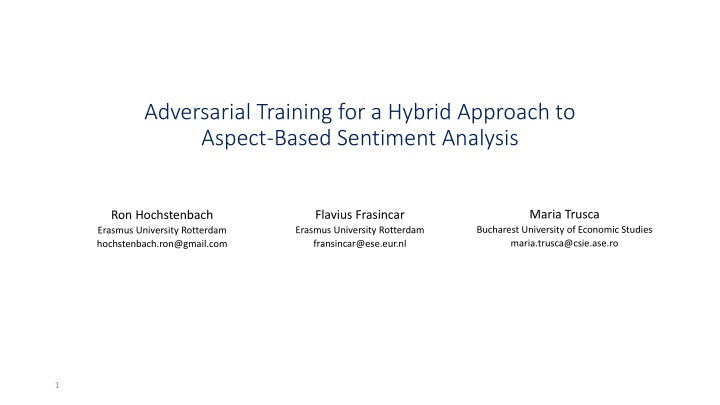
Innovative Approach to Aspect-Based Sentiment Analysis
Enhance sentiment analysis using adversarial training with Cat-GANs for better performance in aspect-based sentiment analysis. Explore aspects like sentiment category detection, opinion target extraction, and sentiment classification. Utilize domain sentiment ontology and a deep neural network for a robust model.
Download Presentation

Please find below an Image/Link to download the presentation.
The content on the website is provided AS IS for your information and personal use only. It may not be sold, licensed, or shared on other websites without obtaining consent from the author. If you encounter any issues during the download, it is possible that the publisher has removed the file from their server.
You are allowed to download the files provided on this website for personal or commercial use, subject to the condition that they are used lawfully. All files are the property of their respective owners.
The content on the website is provided AS IS for your information and personal use only. It may not be sold, licensed, or shared on other websites without obtaining consent from the author.
E N D
Presentation Transcript
Adversarial Training for a Hybrid Approach to Aspect-Based Sentiment Analysis Maria Trusca Flavius Frasincar Erasmus University Rotterdam fransincar@ese.eur.nl Ron Hochstenbach Erasmus University Rotterdam hochstenbach.ron@gmail.com Bucharest University of Economic Studies maria.trusca@csie.ase.ro 1
Aspect Aspect- -based Sentiment Analysis (ABSA) based Sentiment Analysis (ABSA) Aspect Category Detection: identifies the pair Entity#Aspect, e.g. Food#Quality; Opinion Target Extraction: identifies the expression used in the text to describe the aspect, e.g. pad se ew chicken; Sentiment Classification: finds the sentiment label of the pair Entity#Aspect. 2
Our Approach Our Approach Given the following benefits of adversarial training in the field of affective computing and sentiment analysis: The sparse availability of labeled sentiment data is overcome; The generated emotions are more natural and more understandable to humans; The trained models are more robust as the problems with samples gathered from different contexts are reduced; The quality evaluation of the generated samples is automatically executed. we rely on the Categorical Generative Adversarial Networks (Cat-GANs) to enhance the performance of a state-of-the-art model developed for ABSA, by better recognizing the input characteristics of instances belonging to different sentiment classes. 3
Baseline Approach Baseline Approach Domain Sentiment Ontology Deep Neural Network 4
Domain Sentiment Ontology Domain Sentiment Ontology The domain sentiment ontology has three main classes: SentimentMention class represents sentiment expressions; AspectMention class identifies aspects related to sentiment expressions; SentimentValue class groups aspects in the Positive and Negative subclasses based on the type of sentiment expression. Generic sentiment expression Aspect-specific sentiment expression Varying sentiment expression 5
LCR LCR- -Rot Rot- -hop ++ hop ++ The backup model is a Left-Center-Right Separated Neural Network with Hierarchical Rotatory Attention. The main layers of the neural network are: Input (word embeddings) LSTM (context-based word embeddings) Hierarchical Rotatory Attention (applied multiple times) Target2context vectors ??= ?=1 ?? context) Context2target vectors ???= ?=1 ?? context) Where ?? hidden states MLP layer ? ? ? ? (example for the left ?? ? ? ? (example for the left ?? are attention scores and ? ? and ?? ? and ? ? are 6
Cat Cat- -GAN GAN Discriminator (D): the LCR-Rot-hop++ neural network is adjusted to work as a discriminator that should distinguish not only sentiment classes but also the generated (fake) instances. Generator (G): A fully connected 4-layer MLP is used to encode randomly generated inputs similar to the real input instances. 7
Cat Cat- -GAN GAN Knowing that J and I are the batches of real and generated samples, and D( ) represents the probability that the data is real or generated, the loss function of the Cat-GAN neural network is defined as: ??,?= ?? log ?? ?? log ?? + ? ? ? ? 2+ | ?|2) ?( ? or: ??,?= log[??(??)] log[1 ??(?( ?))] + ? ? ? ? 2+ | ?|2) ?( ? and is solved as an optimization problem: max ? min ? ??,? 8
Cat Cat- -GAN GAN Implementation details Implementation details The minimax game implemented by the Cat-GAN neural network is able to converge or to reach its optimum if: The generator is updated at each k-th iteration (the discriminator reaches its optimum given an instance of the generator before the generator is updated again); The learning rates and momentum terms of the generator are modified with respect to the discriminator as follows: ?????= ??? ????? ??? ??????= ???? ?????? The loss function includes the L2-regularization term, and the dropout adjusts the layers of the neural network; 9
Results Results The comparison between the baseline model HAABSA++ and HAABSA*: To get a better understanding of how the backup neural network performs for both HAABSA++ and HAABSA*, the accuracies without ontology are also reported. SemEval 2015 SemEval 2016 In-sample Out-of-sample In-sample Out-of-sample w ontology HAABSA++ 88.8% 81.7% 91.0% 84.4% HAABSA* 89.7% 82.5% 91.5% 87.3% w/o ontology HAABSA++ 94.9% 80.7% 95.1% 80.6% HAABSA* 96.6% 82.2% 96.2% 88.2% 10
Conclusion and Future Work Conclusion and Future Work In this work, we extended the backup neural network of a state-of-the-art hybrid approach method for ABSA using adversarial training. Overall, the GAN-based HAABSA model increased the testing accuracy as follows: With ontology: +0.8 p.p. (SemEval 2015), +2.9 p.p. (Semeval 2016); Without ontology: +0.5 p.p. (SemEval 2015), +7.6 p.p. (SemEval 2016). Future work: Investigate the effect of different input perturbations as an alternative of the random input generation; Refine the neural network of the generator. 11
Thank you! Thank you! The code can be found The code can be found at at https:// https://github.com/RonHochstenbach/HAABSAStar github.com/RonHochstenbach/HAABSAStar 13
